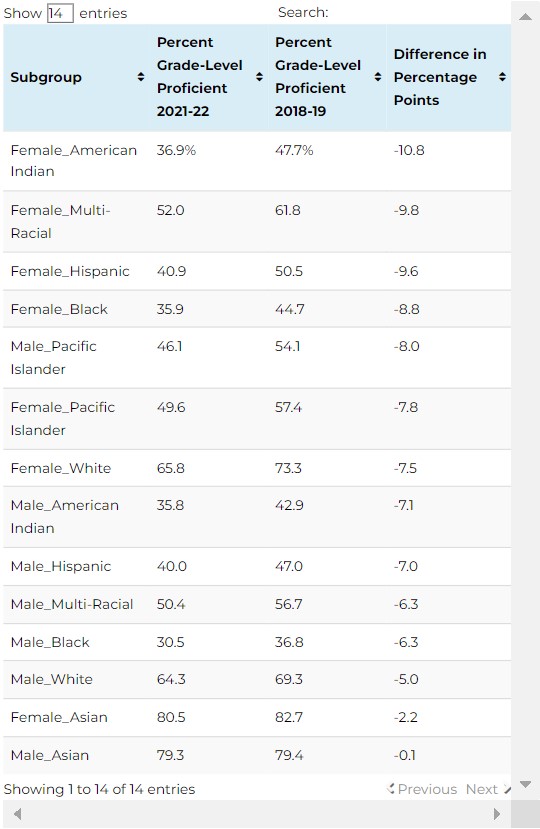The Shell Game of Corrupted Government Exposed
North Carolina Policymakers Must Improve Academic Outcomes for These Two Groups
Publisher's Note: This post appears here courtesy of the John Locke Foundation. The author of this post is Dr. Terry Stoops.
Teacher unions, public school advocacy organizations, and other opponents of standardized testing are correct when they declare that tests cannot measure everything about a child, a teacher, or a school. But that fact simply means that test results are incomplete, not irrelevant. Standardized tests serve three critical functions: establishing minimum academic standards for high school graduation, creating a diagnostic tool that educators can use to improve instruction, and holding schools accountable for results.
North Carolina measures student performance in two ways: growth and proficiency. Growth analyses (or value-added scores) employ advanced statistical techniques to project the future performance of individual students based on their past performance. The difference between students' projected and actual performance determines whether the students have met, not met, or exceeded growth. Proficiency rates reflect the number of test items answered correctly. Thus, proficiency rates reflect students' mastery of the subject matter. Each metric has advantages and disadvantages, which is one reason why both are included in school performance grade calculations.
Earlier this year, the North Carolina Department of Public Instruction's Office of Learning Recovery and Acceleration partnered with SAS Institute Inc. to analyze state test score growth data during pandemic-affected school years. In "An Impact Analysis of Student Learning During the COVID-19 Pandemic," they concluded that the loss of instructional time during the pandemic had produced "a negative impact for all students, for all grades, for almost every subject (except English II)." Math (5th through 9th grade) and Science (Biology) were the hardest hit.
My analysis compares disaggregated proficiency rates from 2019 and 2022. Note that the student subgroups in these two years are not identical. Entry and exit from public schooling, grade-level promotion, student relocation, graduation, and changes to demographic designations change the composition of student subgroups annually. That is why I avoid comparisons of grade-level proficiency rates across years.
Female students in nearly every racial/ethnic subgroup recorded larger drops in proficiency rates than their male counterparts (see Table 1). This is consistent with the Office of Learning Recovery and Acceleration study, which concluded, "Despite early predictions that male students were more negatively impacted than female students, this was not true on average."
Table 1. Proficiency Rates by Sex and Race/Ethnicity

Researchers have yet to offer convincing explanations for the drop in female student scores. One viable hypothesis is that female students confronted greater social-emotional challenges during lockdowns. Those challenges, in turn, impeded learning. Despite sizable proficiency decreases, female student subgroups still outperformed male students in 2022.
In terms of proficiency, the Black male subgroup is the most worrisome of the bunch. Black males struggled long before the pandemic, but the 2022 proficiency rates are alarming. Across all subjects and grades, only 30.5% of Black male students reached grade-level proficiency last school year, 21 percentage points lower than the statewide rate. Grade-level proficiency rates for black males range from a low of 17.3% in Math 1 to a high of 54.3% in 8th-grade science (see Table 2).
Table 2. Proficiency Rates for Black Male Students, 2021-22

Educators recognize that low academic achievement among Black male students is a problem that requires action. Social justice platitudes are plentiful, but solutions are in short supply. Empirical evidence suggests that students may benefit from changing the racial composition of the public school teacher workforce, but we lack proven strategies for recruiting and retaining a sufficient number of teachers of color.
Perhaps a better approach is to continue to expand parental school choice. A 2019 study published by the Thomas B. Fordham Institute found that Black students in North Carolina charter schools are more likely to have black teachers than their peers in traditional public schools. In fact, Black students in charter schools were more than 50 percent more likely to have at least one black teacher compared to their counterparts in district schools. American University professor Seth Gershenson, the study's author, concluded that this student-teacher race match could lead to academic gains in math.
Educational entrepreneurs also should consider creating schools of choice for female K-12 students. After all, they have the choice to attend one of the state's excellent private women's colleges for undergraduate or graduate study. While North Carolina has a handful of single-sex district and charter schools, I believe families would welcome additional K-12 educational options that prioritize the academic and social-emotional needs of girls and young women.
Go Back
- Between 2019 and 2022, female students generally recorded larger drops in proficiency rates than their male counterparts
- Across all subjects and grades, only 30.5% of Black male students reached grade-level proficiency last school year
- Both groups could benefit from expanded parental school choice programs
Teacher unions, public school advocacy organizations, and other opponents of standardized testing are correct when they declare that tests cannot measure everything about a child, a teacher, or a school. But that fact simply means that test results are incomplete, not irrelevant. Standardized tests serve three critical functions: establishing minimum academic standards for high school graduation, creating a diagnostic tool that educators can use to improve instruction, and holding schools accountable for results.
North Carolina measures student performance in two ways: growth and proficiency. Growth analyses (or value-added scores) employ advanced statistical techniques to project the future performance of individual students based on their past performance. The difference between students' projected and actual performance determines whether the students have met, not met, or exceeded growth. Proficiency rates reflect the number of test items answered correctly. Thus, proficiency rates reflect students' mastery of the subject matter. Each metric has advantages and disadvantages, which is one reason why both are included in school performance grade calculations.
Earlier this year, the North Carolina Department of Public Instruction's Office of Learning Recovery and Acceleration partnered with SAS Institute Inc. to analyze state test score growth data during pandemic-affected school years. In "An Impact Analysis of Student Learning During the COVID-19 Pandemic," they concluded that the loss of instructional time during the pandemic had produced "a negative impact for all students, for all grades, for almost every subject (except English II)." Math (5th through 9th grade) and Science (Biology) were the hardest hit.
My analysis compares disaggregated proficiency rates from 2019 and 2022. Note that the student subgroups in these two years are not identical. Entry and exit from public schooling, grade-level promotion, student relocation, graduation, and changes to demographic designations change the composition of student subgroups annually. That is why I avoid comparisons of grade-level proficiency rates across years.
Female students in nearly every racial/ethnic subgroup recorded larger drops in proficiency rates than their male counterparts (see Table 1). This is consistent with the Office of Learning Recovery and Acceleration study, which concluded, "Despite early predictions that male students were more negatively impacted than female students, this was not true on average."
Table 1. Proficiency Rates by Sex and Race/Ethnicity

Researchers have yet to offer convincing explanations for the drop in female student scores. One viable hypothesis is that female students confronted greater social-emotional challenges during lockdowns. Those challenges, in turn, impeded learning. Despite sizable proficiency decreases, female student subgroups still outperformed male students in 2022.
In terms of proficiency, the Black male subgroup is the most worrisome of the bunch. Black males struggled long before the pandemic, but the 2022 proficiency rates are alarming. Across all subjects and grades, only 30.5% of Black male students reached grade-level proficiency last school year, 21 percentage points lower than the statewide rate. Grade-level proficiency rates for black males range from a low of 17.3% in Math 1 to a high of 54.3% in 8th-grade science (see Table 2).
Table 2. Proficiency Rates for Black Male Students, 2021-22

Educators recognize that low academic achievement among Black male students is a problem that requires action. Social justice platitudes are plentiful, but solutions are in short supply. Empirical evidence suggests that students may benefit from changing the racial composition of the public school teacher workforce, but we lack proven strategies for recruiting and retaining a sufficient number of teachers of color.
Perhaps a better approach is to continue to expand parental school choice. A 2019 study published by the Thomas B. Fordham Institute found that Black students in North Carolina charter schools are more likely to have black teachers than their peers in traditional public schools. In fact, Black students in charter schools were more than 50 percent more likely to have at least one black teacher compared to their counterparts in district schools. American University professor Seth Gershenson, the study's author, concluded that this student-teacher race match could lead to academic gains in math.
Educational entrepreneurs also should consider creating schools of choice for female K-12 students. After all, they have the choice to attend one of the state's excellent private women's colleges for undergraduate or graduate study. While North Carolina has a handful of single-sex district and charter schools, I believe families would welcome additional K-12 educational options that prioritize the academic and social-emotional needs of girls and young women.





















